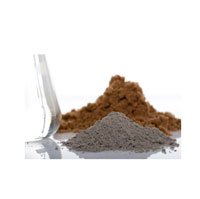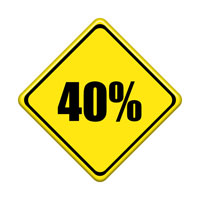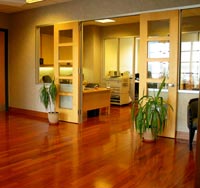Doing It Right the First Time Is Green

In the constant search for finding new ways to better manage environmental resources and to provide “greener” building technology, it is understandable that research into new and innovative technologies and materials have been forefront in industry news. This has applied to concrete in a number of ways – experimental aggregates, changes to sealants and adhesives, and a variety of admixtures that serve both functional and decorative purposes.
We’d also like to add a reminder to the discussion: If any concrete is installed with proper attention given to moisture measurement during the drying process, it ultimately benefits the environment, the industry and the individual professionals that rely on concrete in their trades. Doing it right the first time significantly minimizes the negative impact that moisture-compromised concrete will always present in terms of environmental stewardship.
“New” moisture measurement – RH testing
The same significant changes that have swept through the concrete industry have also been happening in the science of understanding moisture measurement. Concrete has certainly proven its ability to withstand the tests of time, but as we understand more about what lets it reach its strongest, more research has been directed at the first stages of concrete installation – the curing and drying stages.
 Curing, or hydration, is simply the chemical change that happens as the three main ingredients of concrete combine – the water, the cement and the aggregate. That chemical reaction is the first step in concrete’s proven strength and durability.
Curing, or hydration, is simply the chemical change that happens as the three main ingredients of concrete combine – the water, the cement and the aggregate. That chemical reaction is the first step in concrete’s proven strength and durability.
Drying is the next crucial step in the process and is the period of time after hydration when the excess moisture from the concrete mixture must make its way to the surface and evaporate away. It is during this time that the strength of the slab is established, and rushing the drying process can significantly impact the concrete’s performance.
So how have we typically determined that the concrete is dry?
While we don’t know how the ancient Romans decided concrete was dry, we do know several test methods that have been used over the past century.
- Rule of thumb
Every industry has its historical knowledge – the tips and processes passed down from generation to generation. In concrete, the rule of thumb for drying concrete is “30 days per inch of slab depth”. It may be helpful for setting a general schedule, but considering the number of variables that can impact the drying rate of concrete, it’s no guarantee that the slab will be dry in a specific number of days. - Plastic sheet method
The basic principle of the plastic sheet method is that if a significant amount of moisture is still exiting the slab’s surface, it must still be wet. By taping a plastic sheet to the surface of the slab, the amount of condensation that collects under the plastic could indicate the presence of excess moisture still in the slab. Helpful, perhaps, but hardly definitive. - The hood method
Basically a variant of the plastic sheet method, a plastic dome is sealed to the slab and after a set period of time the amount of condensation under the hood is assessed. - Calcium chloride testing
In the 1940s, a test method appeared in the flooring industry that was referred to as a “dampness test”. It placed a small amount of desiccant (calcium chloride) under a glass dish sealed to the slab and left it to sit overnight. In the test’s original form, if the desiccant looked wet in the morning, the slab was considered wet. If it didn’t, the slab was considered dry. There was no quantifiable result. But as this test evolved in use over time, it was decided that the weight change of the desiccant after 72 hours on the slab could be used to calculate the amount of moisture that remained in the slab. The results of the calcium chloride test, known as the Moisture Vapor Emission Rate (MVER), became the industry standard for many decades. - Relative humidity testing
 In the 1980s, research began in Sweden that examined the actual drying process of concrete and began looking at a new method for testing. What developed was the use of in situ testing, where sensors or probes were placed in holes drilled in the concrete slab to give a better indication of the moisture content levels. Further experimentation, carried on both there and in the US, demonstrated that sensors placed at 40% of the slab depth (for slabs drying from one side) would ultimately give a measurement that would correspond to the final moisture level of the slab if it were sealed (i.e., a flooring applied) at that point.RH testing was the first concrete moisture test method to have a scientific basis for the methodology and the results. And that changed the face of concrete moisture testing.
In the 1980s, research began in Sweden that examined the actual drying process of concrete and began looking at a new method for testing. What developed was the use of in situ testing, where sensors or probes were placed in holes drilled in the concrete slab to give a better indication of the moisture content levels. Further experimentation, carried on both there and in the US, demonstrated that sensors placed at 40% of the slab depth (for slabs drying from one side) would ultimately give a measurement that would correspond to the final moisture level of the slab if it were sealed (i.e., a flooring applied) at that point.RH testing was the first concrete moisture test method to have a scientific basis for the methodology and the results. And that changed the face of concrete moisture testing.
RH testing makes the use of “greener” options more predictable
One of the first applications to really demonstrate the difference that choosing the right concrete moisture test method can make was with the introduction of lightweight concrete.
Lightweight concretes were developed with several benefits in mind. They reduce the load weight of the concrete structure with a minimal loss in strength (depending on the specific batch ingredients), are lighter to transport (providing a cost savings when moving precast elements), and can be mixed with a variety of natural aggregates. They were also found to provide improved fire resistance and thermal properties.
Where they did not provide a benefit was in situations where calcium chloride (CaCl) testing – a time-honored standard in the concrete industry – was used to determine if the slab was dry enough to proceed with a flooring application. What was an acceptable margin of error with standard concrete suddenly became a liability to flooring professionals receiving callbacks to fix moisture-related flooring problems. Eventually, the limitations of CaCl testing for lightweight concrete proved problematic enough that the ASTM specifically disallowed CaCl testing for lightweight concrete applications and indeed, called its credibility into question for all concrete types.
In the meantime, relative humidity (RH) testing provided a much more specific, and scientifically-backed, understanding of the drying cycle of concrete and the moisture conditions inside a drying concrete slab. In addition, RH testing didn’t face the same limitations as CaCl testing or other surface-based test methods for lightweight concrete because it tests within the slab at the correct depth proven to give actionable readings.
What does this mean for other “greener” concrete types? With the variety of admixtures and aggregates on the market today, RH testing still provides the best possible test method for accurately measuring the moisture conditions in any concrete slab. RH testing, like the Rapid RH®, allows up-to-date, repeatable testing of moisture conditions IN the slab so that flooring professionals and building specialists can accurately determine not only the correct condition of the slab, but also the most viable options for flooring adhesives and products necessary to meet the building schedule.
RH testing protects the lifespan of installed flooring
 Moisture-related problems in concrete cost the building industry millions of dollars every year. Whether that’s osmotic blistering in a concrete surface or flooring failure in a gymnasium, every time excess moisture in a concrete slab puts the installed flooring at risk, there are costs in materials, labor and even health for occupants – all of which place a burden on the environment in the long run. Damaged materials must be dumped or recycled, and additional products are required for repair or remediation.
Moisture-related problems in concrete cost the building industry millions of dollars every year. Whether that’s osmotic blistering in a concrete surface or flooring failure in a gymnasium, every time excess moisture in a concrete slab puts the installed flooring at risk, there are costs in materials, labor and even health for occupants – all of which place a burden on the environment in the long run. Damaged materials must be dumped or recycled, and additional products are required for repair or remediation.
Of course, concrete is actually recyclable and can be crushed for re-use as an aggregate itself (or can be made with recycled by products from other sources), but ultimately, the longer it can stay in service, the lower its overall impact on the environment. With accurate RH testing, the lifespan of any flooring system installed over concrete can be protected for optimal strength and performance.
The real secret is making sure any concrete is designed, mixed and installed for optimal performance and minimal moisture-related damage. When it’s done right at the beginning, it will serve its purpose far into a sustainable future.
Accurate, affordable RH testing serves as insurance against the costs, both financial and environmental, of moisture-related problems in concrete. That’s green that is worth investing in.